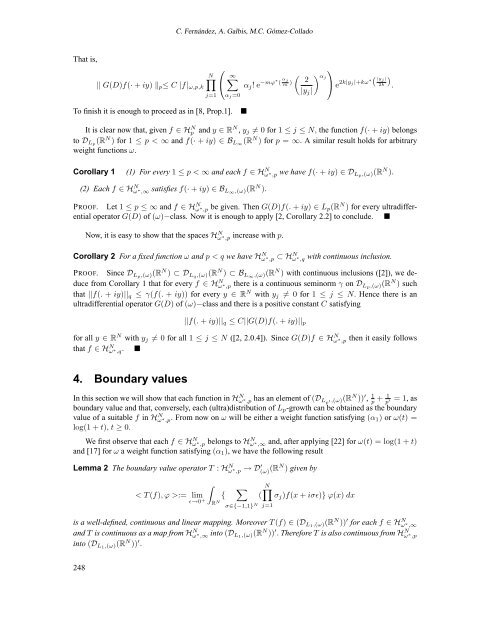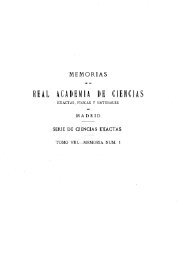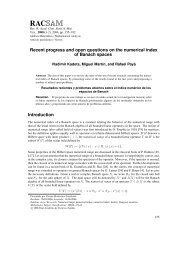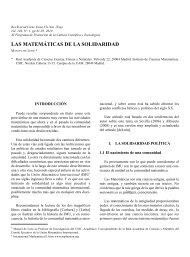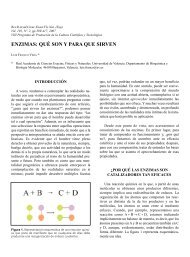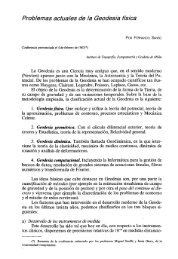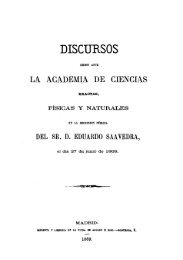Holomorphic Functions
Holomorphic Functions
Holomorphic Functions
Create successful ePaper yourself
Turn your PDF publications into a flip-book with our unique Google optimized e-Paper software.
C. Fernández, A. Galbis, M.C. Gómez-ColladoThat is,‖ G(D)f(· + iy) ‖ p ≤ C |f| ω,p,kN ∏⎛⎝∞∑j=1 α j=0To finish it is enough to proceed as in [8, Prop.1].⎞( ) αjα j ! e −mϕ∗ ( α j 2m ) |y j |( |yj⎠ e 2k|yj|+kω∗ |2k).It is clear now that, given f ∈ HpN and y ∈ R N , y j ≠ 0 for 1 ≤ j ≤ N, the function f(· + iy) belongsto D Lp (R N ) for 1 ≤ p < ∞ and f(· + iy) ∈ B L∞ (R N ) for p = ∞. A similar result holds for arbitraryweight functions ω.Corollary 1 (1) For every 1 ≤ p < ∞ and each f ∈ H N ω ∗ ,p we have f(· + iy) ∈ D Lp,(ω)(R N ).(2) Each f ∈ H N ω ∗ ,∞ satisfies f(· + iy) ∈ B L∞,(ω)(R N ).PROOF. Let 1 ≤ p ≤ ∞ and f ∈ Hω N ∗ ,p be given. Then G(D)f(. + iy) ∈ L p (R N ) for every ultradifferentialoperator G(D) of (ω)−class. Now it is enough to apply [2, Corollary 2.2] to conclude. Now, it is easy to show that the spaces H N ω ∗ ,p increase with p.Corollary 2 For a fixed function ω and p < q we have H N ω ∗ ,p ⊂ H N ω ∗ ,q with continuous inclusion.PROOF. Since D Lp,(ω)(R N ) ⊂ D Lq,(ω)(R N ) ⊂ B L∞,(ω)(R N ) with continuous inclusions ([2]), we deducefrom Corollary 1 that for every f ∈ Hω N ∗ ,p there is a continuous seminorm γ on D Lp,(ω)(R N ) suchthat ||f(. + iy)|| q ≤ γ(f(. + iy)) for every y ∈ R N with y j ≠ 0 for 1 ≤ j ≤ N. Hence there is anultradifferential operator G(D) of (ω)−class and there is a positive constant C satisfying||f(. + iy)|| q ≤ C||G(D)f(. + iy)|| pfor all y ∈ R N with y j ≠ 0 for all 1 ≤ j ≤ N ([2, 2.0.4]). Since G(D)f ∈ Hω N ∗ ,p then it easily followsthat f ∈ Hω N ,q. ∗4. Boundary valuesIn this section we will show that each function in Hω N ∗ ,p has an element of (D Lp ′ ,(ω)(R N )) ′ , 1 p + 1 p= 1, as′boundary value and that, conversely, each (ultra)distribution of L p -growth can be obtained as the boundaryvalue of a suitable f in Hω N ,p. From now on ω will be either a weight function satisfying (α ∗ 1 ) or ω(t) =log(1 + t), t ≥ 0.We first observe that each f ∈ H N ω ∗ ,p belongs to H N ω ∗ ,∞ and, after applying [22] for ω(t) = log(1 + t)and [17] for ω a weight function satisfying (α 1 ), we have the following resultLemma 2 The boundary value operator T : H N ω ∗ ,p → D ′ (ω) (RN ) given by∫< T (f), ϕ >:= lim {ɛ→0 + R N∑(σ∈{−1,1} N j=1N∏σ j )f(x + iσɛ)} ϕ(x) dxis a well-defined, continuous and linear mapping. Moreover T (f) ∈ (D L1,(ω)(R N )) ′ for each f ∈ H N ω ∗ ,∞and T is continuous as a map from H N ω ∗ ,∞ into (D L1,(ω)(R N )) ′ . Therefore T is also continuous from H N ω ∗ ,pinto (D L1,(ω)(R N )) ′ .248


